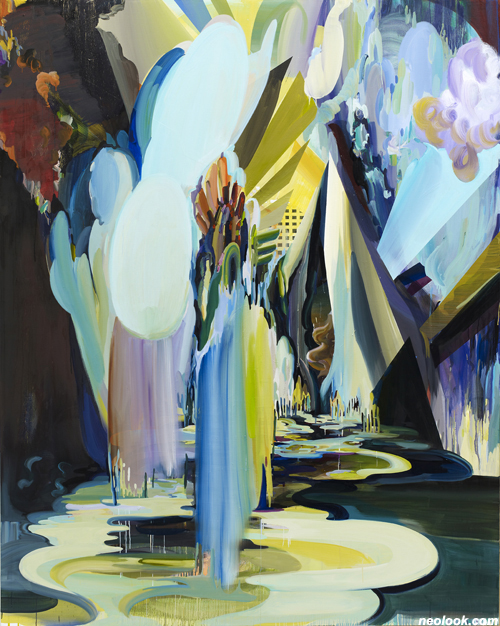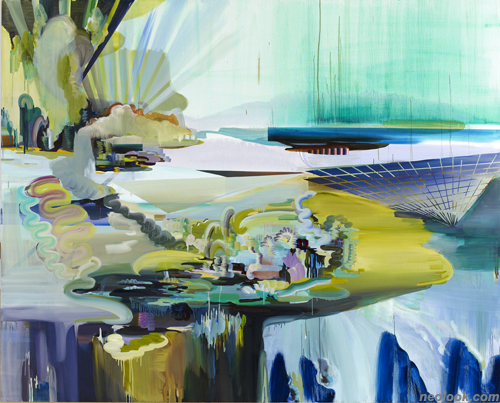- ● homepage
- ● archives
- ● restoration
- ● books
- ● big banners
- ● post board
- ■ neo's search
- ■ about us
- ■ 게재방법 안내
- 개인정보처리방침

- [email protected]
- Tel. 02_335_7922
- Fax. 02_335_7929
- 10:00am~04:30pm
- 월요일~금요일
- 3/3(월) 대체공휴일

관찰자의 포스트모더니즘 - 개념의 풍경화
이진한展 / LEEJINHAN / 李眞韓 / painting 2012_0209 ▶ 2012_0317

- 이진한_Supersaturation_캔버스에 유채, 아크릴채색, 과슈, 글리터, 마스킹 테이프_250×200cm_2011
오프닝 리셉션 / 2012_0209_목요일_06:00pm
후원 / 한국문화예술위원회
관람시간 / 11:00am~08:00pm
대안공간 루프 ALTERNATIVE SPACE LOOP 서울 마포구 서교동 335-11번지 Tel. +82.2.3141.1377 www.altspaceloop.com
동양의 관점으로 바라보면, 우리의 삶은 인과율로 덮여 있다. 즉 모든 만남과 사건에는 원인과 결과가 존재한다. 그리고 그것은 궁극적으로 관계와 인연을 만들어낸다. 모든 존재는 타자와의 관계 속에서 존재할 수 있으며, 특히 우리의 육신이 영혼과 결합해 생존하는 현상계에서 더욱 그러하다. 고로 이 세계는 인연이 거미줄처럼 얽혀 있는 인드라-망이라고 말할 수 있을 것이다. 그리고 이러한 모종의 법칙을 불교에서는 연기(緣起)라고 한다.

- 이진한_Landscape with a Spiderman_리넨에 유채, 아크릴채색, 스티커_227×600cm_2011

- 이진한_Landscape with a Spiderman 1.3_리넨에 유채, 아크릴채색_227×182cm_2011
흥미로운 사실은 이러한 법칙이 지금 이 시대에도 통용되고 있다는 것이다. 이미 많은 자가 말해왔듯, 포스트모더니즘에서 관계는 매우 중요한 요소로 작용하고 있으며, 그로 인해 중심과 주변은 수직구조가 아닌 수평구조로 재편성될 수 있었다. 이는 비단 인간과 인간 사이에서만 적용되지 않는다. 아니 인간과 비-인간 그리고 시간 혹은 공간에까지 확장되어 있다. 그리고 특이한 점은 이러한 원리에는 동양의 사상 그리고 불교의 교리와 유사한 점이 있다는 것이다. 나는 이진한의 작업에서 이질적인 공간인 하나의 레이어와 또 다른 레이어가 그리고 이질적인 시간인 과거와 현재 그리고 미래가 이처럼 수평적 관계 속에 공존하고 있는 광경을 발견할 수 있었다. ● 포스트모더니즘의 출현에 공헌한 데리다의 경우, 시간과 공간의 개념을 규명하면서, 공간은 이질적인 것을 동시에 존재하도록 하는 시간과 '짜여 있는 것(com-plicity)'이라고 했다. 그리고 이렇듯 동일성을 깨뜨리는 이질성을 '간격(interval)'이라 불렀다. 이진한의 작업에서는 이러한 '간격들이 동시에 펼쳐지면서 새로운 수평적 관계를 만들어내는 일종의 사건'이 드러나고 있다. 물론 그 간격은 공간뿐만 아니라 시간에도 해당된다. 작가는 "최근 작업에서 레이어 사이의 불편하고 상이한 관계를 연구하는 데 초점을 맞추고 있다."고 말한 바 있다. 그리고 이는 아마도 동질성으로 규명된 공간(캔버스)과 시간(현재) 위에 이질적인 것들을 공존케 하는 데서 발생한 듯하다.

- 이진한_Landscape with a Spiderman 2.3_리넨에 유채, 아크릴채색, 스티커_227×182cm_2011

- 이진한_Landscape with a Spiderman 3.3_리넨에 유채, 아크릴채색_227×182cm_2011
또한 이진한의 작업에서는 의도적으로 이질적인 것들을 생성하고 화해시키는 장치들이 곳곳에 부착되어 있다. 이를 테면, 배경 위에 마스킹 테이프를 부착한 채 그 위에 덧칠을 하고, 기존의 테이프를 제거하면서 배경이 바깥으로 드러나 다른 형상들과 공존하게 되는 것이라든지, 과거 초현실주의자들이 사용하던 드리핑 기법 등의 자동기술법을 폭넓게 활용하면서, 평면 위에 물감의 부피만큼 생겨난 또 다른 레이어가 또 다른 우연적인 관계를 형성하게 되는 것이 그러하다. 이러한 방식으로 그녀의 페인팅에는 물리적인 레이어들이 탄생하였다. 그리고 이렇게 생성된 이질적인 공간들은 마찰과 충돌의 시간을 극복하고, 서로의 존재를 인정하고 이해하는 과정을 거치면서, 결국에는 타자로 인해 현-존재를 공고히 하는 단계에까지 이르고 있다. 이러한 해체와 공존 그리고 새로운 관계성을 양산해내는 것은 시간의 차원에서도 반복되고 있다. 현재 이곳에서 완성되는 그녀의 작업들에는 과거 르네상스의 원근법과 모더니즘 추상회화의 속성이 공존한다. 이러한 행위는 현재를 해체하여 과거가 현재로 흐를 수 있도록 하는 것으로 보이며, 나아가 현재의 행위가 미래로 흘러가도록 하는 것으로도 해석할 수 있을 것 같다. 데리다의 시간과 공간의 개념처럼 그리고 불교의 연기설처럼 말이다. 이는 앞에서 말한 것과 반대로 규정되어 있는 하나의 공간이 이질적인 시간을 얽어 매는 것으로 볼 수 있을 것이다. 여기서 우리가 주의해야 하는 것은 '얽어 맨다는 것'은 존재를 훼손하지 않으면서, 공존케 하는 방식이라는 것이다.

- 이진한_Pineapple_캔버스에 유채, 아크릴채색, 과슈, 글리터, 마스킹 테이프_160×160cm_2011
그린버그의 모더니즘 회화론은 오직 회화적인 것으로 회화를 말하는 데 중점을 두었다. 하지만 이미 '작품 속에 내재해 있는 환영의 요소'와 '평면성의 불가능성'에 부딪혀 좌절된 바 있다. 이진한의 작업은 의도적으로 이러한 평면성을 거부하고, 페인팅 안에 새로운 레이어들을 구축하고 드러내는 데 집중되어 있는 듯하다. 하지만 모순적이게도 이러한 방식은 그녀의 작품에서 새로운 회화성에 대한 고민을 하도록 한다. 데리다의 말처럼, 순수함은 오염된 것에 의해 규명될 수 있으며, 기원은 흔적에 의해 상상되고 추측될 수 있기 때문이다. 즉 이 말은 반-회화적 요소들로 인해 진정한 회화의 속성에 대해 고민케 한다는 것이다. 물론 이는 동양인이라는 작가의 아이덴티티와 이방인으로서 서양미술사를 읽어온 시간으로 가능해졌을 것이다. 데리다의 이론이 종종 동양사상과 연결되어 해석되어왔다고, 그의 사상의 기반이 동양에 있을지도 모른다는 상상을 하는 것은 매우 위험한 일이다. 그리고 실제로 그는 단 한 번도 이에 수긍한 바가 없다. 하지만 그럼에도 불구하고 데리다의 해체론을 동양사상에서의 관계성에 대한 것과 불교에서의 연기설과 연결하여 보는 것은 무리한 시도는 아닌 것 같다. 그리고 데리다의 해체론에 매우 입각해 있으며, 관계성에 대한 동양사상의 이야기가 매우 적용되고 있는 이진한의 작업은 고로 어떤 면에서는 서구화되어 있으나, 그 저변에 존재하는 동양적 관념을 매우 강하게 드러내고 있다고 볼 수 있을 것 같다. 고로 우리는 그녀의 작업을 통해 포스트모더니즘 시대의 새로운 회화의 요소와 관계성 그리고 동양성에 대해 생각해볼 수 있을 것이다. ■ 김지혜

- 이진한_Yellow Submarin_리넨에 유채_200×250cm_2011
From the standpoint of Eastern philosophy, life revolves around the principle of causality. Every encounter occurs as cause and effect react upon each other, and each encounter ultimately generates ties and relations. All members of the universe exist within mutual relations, especially in the psychophysical phenomena. The psychophysical phenomena may be said to be Indra's net, which symbolizes a mutually interdependent web of cause and effect. This general truth is called dependent origination in Buddhism philosophy. ● What is noteworthy is that this truth still universally applies in today's world. As many philosophers in history maintained, mutual relations are the key to the understanding of post-modernism. Interdependence and mutual relations are what enable the central and surrounding components to be realigned horizontally, not hierarchically. Not only relations between human beings, but also inanimate objects, time, and space fall within its orbit. An interesting turn is that this truth displays many similarities to Oriental philosophy and Buddhist doctrines. I discovered in Jinhan LEE's work the landscapes where disparate spaces and disparate frames of time (past, present, and future), layer by layer, co-exist and form horizontal relations. ● According to Jacques DERRIDA, a French philosopher and contributor to the advent of post-modernism, space is interwoven with time that allows disparate individuals and objects to co-exist simultaneously. He referred to this disparity that upsets identity the "interval". LEE's work renders a sort of "event" that unfolds by laying out such "intervals" all at once and creating new horizontal relations between them. Of course, these intervals involve both space and time. The artist states, "The main explanation of my current paintings is the awkward and strange relationship between layers." She makes this possible by rendering objects of disparity on the space of identity (the canvas) within the frame of time of identity (the present). ● What is more, the devices that intentionally generate disparate objects and create a harmony among them are found in different corners. In one painting, the artist has covered the background with masking tape, painted over it, and removed it to make the background stand out and encompass the other objects at the same time. In another piece, she has made an extensive use of the "drip style" often employed by surrealist painters in the past. She has created an array of physical layers using this technique and allowed each layer of paint drippings to form accidental relations with another. Disparate spaces generated on the painting work to wade through frictions and conflicts, recognize and understand each other's existence, and finally arrive at the stage of reinforcing their presence through mutual relations. This process of deconstruction, acceptance of co-existence, and expansion of interdependence is repeated over disparate frames of time. Her paintings incorporate attributes of Renaissance perspective in combination with abstract modernist paintings. It may be translated as an attempt to deconstruct the present so that the past can flow into the present, and, going a step forward, so that the present can connect with the future, as stated by DERRIDA and Buddhist Philosophy's idea of dependent origination. Contrary to the aforementioned, this can be viewed as space binding a disparate frame of time. What must be noted here is that "binding" indicates making co-existence possible without damaging the components within. ● Clement GREENBERG's ideas on modernist art concentrated on explaining a painting through the instrument of painting. However, he was held back by "illusions implicit in paintings" and "the impossibility of the plane". LEE's work appears to circumvent the limitations of the plane and remain focused on constructing and unfolding new layers. Ironically, such an approach motivates the audience to discover a new representational method and ponder its significance. As DERRIDA said, the purity can be measured against something tainted, and the origin can be conjectured through traces and remains. In the same manner, non-pictorial components can serve as an instrument by which the true attributes of a painting are highlighted. The artist's ethnic background as an Asian and her dedication to the studies of Western art history as a non-Westerner also add to her work's identity. It is dangerous to assume that DERRIDA's ideas stem from Eastern philosophy just because the two are frequently linked together. In fact, DERRIDA has never agreed with such an assumption. However, it does not appear to be far-fetched to try to find similarities between DERRIDA's deconstructionism, mutual relations of Eastern philosophy, and dependent origination of Buddhist philosophy. LEE's artworks, reflective of both deconstructionism and mutual relations, displays the features of Western art to some extent while at the same time revealing the powerful underlying base of Eastern concepts. LEE's work provides us the opportunity to reflect upon how the new components of post-modernist art are influenced by mutual relations and Eastern philosophy. ■ KIMJIHYE
Vol.20120209c | 이진한展 / LEEJINHAN / 李眞韓 / painting
